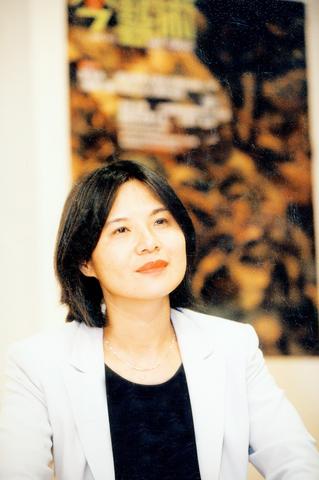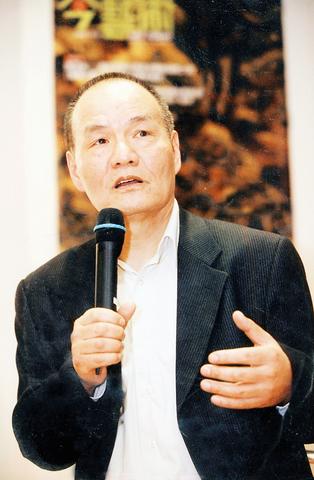Aspiring to create what Flash Art magazine is to contemporary European art, Katy Chien
The characters for "art" become Yishu in pinyin, giving the Vancouver-based magazine a Chinese flavor.

"The staff in Taiwan at first tried to make the title sound `western.' These titles were an easy-to-confuse bunch, like `art-something' or `something-art.' It was the staff in Vancouver, many of them Chinese Canadians, that gave the magazine a very Chinese identity by calling it `Yishu,'" Chien said in an interview with Taipei Times. "I hope that in the future, foreigners will come to recognize this word as meaning `art,' just as all non-Chinese know the word `tofu.'"

Upsurge in interest
The timing of Yishu's launch comes hot on the heels of an upsurge in international interest in contemporary Chinese art, which, according to Chien, almost always refers to mainland Chinese and not Taiwanese art.
"When foreigners talk about contemporary Chinese art, they are talking only about mainland. Taiwan has no voice on the international stage," Chien said. "On all the major art occasions in the world, ... the Documenta, for example, how many artists from Taiwan have been recognized there? Unfortunately, there are international politics at play here. That's why we need to make more of an effort to promote Taiwanese art. And that's part of the reason for launching the magazine."
"For English information on mainland art, people have Chinese-art.com [a comprehensive English-language Web site]. We don't have something like that about contemporary art in Taiwan" Chien said.
With this in mind, Yishu flies the `Chinese art' instead of `Taiwanese art' flag. The premier issue of Yishu covers mainland Chinese artists and Chinese immigrant artists in Canada and the US as well as artists from Taiwan. "Frankly, a magazine exclusively about Taiwanese art would draw very few people's attention. We would rather mix all the Chinese artists together and leave it to the reader to discover that a particular artist who interests them is from Taiwan," Chien said.
Currently publishing Art & Collection: Ancient and Art & Collection: Contemporary, Chien's company has thrived during the present recession, thanks to a strategy of catering to different groups with different products.
The two Art & Collection magazines used to be one monthly published by Wealth magazine company. At that time, it targeted art-collectors market, giving commercial works more coverage. In 2000, it became independent from Wealth, and at the same time split into two monthlies, one focusing on antiques and the other on contemporary art, with both increasing the coverage of exhibitions and other art events. Since their separation, the two have seen a significant rise in advertisement revenues compared with CANS and Artist, the other two art magazines in Taiwan. Now Chien hopes targeting another niche market will work for Yishu as well.
For Shengtian Zheng (鄭勝天), the magazine's managing editor who emigrated from Taiwan to Canada several years ago, that market means intellectuals worldwide. "The [appreciation of] contemporary art in China is growing rapidly. Despite such developments, there has been remarkably little in terms of a corresponding amount of theoretical writing. We realized there was a need for a serious and intellectually inclined journal to address this deficiency," Zheng said in an e-mail to the Taipei Times.
Developing his idea with Chien, Zheng came up with Yishu as an answer to the lack of in-depth material on contemporary Chinese art for non-Chinese readers.
About face
Maybe it was the Chinese concern regarding face that made Chien give meticulous attention to Yishu's appearance -- the magazine's impeccable design is a step up from her two Art & Collections.
"We want this publication to show exquisite taste in content, layout and printing," Chien said, pointing to the neat cover design of monochrome red and the pleasantly clean fonts and layout. The often irrelevant photos of artists and scholars during meetings, common in Chinese-language art publications, are reduced to thumbnail size, making room for cleaner text format. However, a casual glance of the pages offers too few explanatory pictures.
"In the future, the volume will be more massive with more and bigger photos. When it comes to works of art, a photo speaks much more than text," Chien said.
Yishu may not need too much text but it needs to be well-written. It took Zheng more than an year to recruit writers and editors with native-speaker-level English who are also versed in contemporary Chinese or Taiwanese art. The staff are all part-timers with jobs in other fields. "So that their horizons are broader," Chien explained.
That broader horizon is what Yishu wants to offer. The first issue roughly focuses on Chinese culture vs contemporary art, with a large portion devoted to transcriptions of interviews with and panel discussions among artist, critics, curators and others.
Although aspiring to be an "academic journal reflecting the scholarship in the field of contemporary Chinese art and culture," in Zheng's words, Yishu is also trying to be accessible to the general public. As the magazine's premiere issue arrives at collectors' homes and college libraries in New York and London, it remains to be seen if it will stay there.

This month the government ordered a one-year block of Xiaohongshu (小紅書) or Rednote, a Chinese social media platform with more than 3 million users in Taiwan. The government pointed to widespread fraud activity on the platform, along with cybersecurity failures. Officials said that they had reached out to the company and asked it to change. However, they received no response. The pro-China parties, the Chinese Nationalist Party (KMT) and Taiwan People’s Party (TPP), immediately swung into action, denouncing the ban as an attack on free speech. This “free speech” claim was then echoed by the People’s Republic of China (PRC),

Exceptions to the rule are sometimes revealing. For a brief few years, there was an emerging ideological split between the Democratic Progressive Party (DPP) and Chinese Nationalist Party (KMT) that appeared to be pushing the DPP in a direction that would be considered more liberal, and the KMT more conservative. In the previous column, “The KMT-DPP’s bureaucrat-led developmental state” (Dec. 11, page 12), we examined how Taiwan’s democratic system developed, and how both the two main parties largely accepted a similar consensus on how Taiwan should be run domestically and did not split along the left-right lines more familiar in

Specialty sandwiches loaded with the contents of an entire charcuterie board, overflowing with sauces, creams and all manner of creative add-ons, is perhaps one of the biggest global food trends of this year. From London to New York, lines form down the block for mortadella, burrata, pistachio and more stuffed between slices of fresh sourdough, rye or focaccia. To try the trend in Taipei, Munchies Mafia is for sure the spot — could this be the best sandwich in town? Carlos from Spain and Sergio from Mexico opened this spot just seven months ago. The two met working in the

Many people in Taiwan first learned about universal basic income (UBI) — the idea that the government should provide regular, no-strings-attached payments to each citizen — in 2019. While seeking the Democratic nomination for the 2020 US presidential election, Andrew Yang, a politician of Taiwanese descent, said that, if elected, he’d institute a UBI of US$1,000 per month to “get the economic boot off of people’s throats, allowing them to lift their heads up, breathe, and get excited for the future.” His campaign petered out, but the concept of UBI hasn’t gone away. Throughout the industrialized world, there are fears that